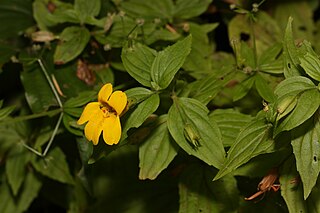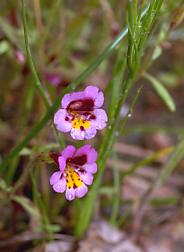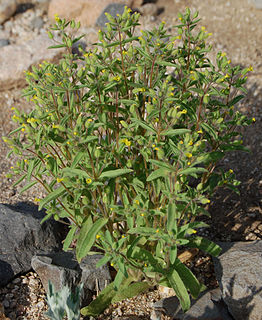
Erythranthe nudata, the bare monkeyflower, is a species of monkeyflower endemic to the serpentine soils of Colusa, Lake and Napa Counties in California. It is an annual flower with bright yellow tube-shaped blooms and small narrow leaves.

Erythranthe lewisii is a perennial plant in the family Phrymaceae. It is named in honor of explorer Meriwether Lewis. Together with other species in Erythranthe, it serves as a model system for studying pollinator-based reproductive isolation. It was formerly known as Mimulus lewisii.
Diplacus aridus, is a species of monkeyflower with yellow blossoms. It was formerly known as Mimulus aridus.
Erythranthe androsacea is a species of monkeyflower known by the common name rockjasmine monkeyflower. It was formerly known as Mimulus androsaceus.

Erythranthe bicolor, the yellow and white monkeyflower, is a species of flowering plant in the lopseed family (Phrymaceae). It is endemic to California, United States. It was formerly known as Mimulus bicolor.

Erythranthe breviflora is a species of monkeyflower known by the common name shortflower monkeyflower. It is native to western North America from British Columbia to Wyoming to the Modoc Plateau and northern Sierra Nevada in California. It grows in moist areas in several types of habitat. It was formerly known as Mimulus breviflorus.
Diplacus congdonii is a species of monkeyflower known by the common name Congdon's monkeyflower.

Erythranthe dentata is a species of monkeyflower known by the common names coastal monkeyflower and toothleaf monkeyflower. It is native to the western coast of North America from British Columbia to northern California, where it grows in moist habitat. It was formerly known as Mimulus dentatus.
Erythranthe exigua is a rare species of monkeyflower known by the common name San Bernardino Mountains monkeyflower. It was formerly known as Mimulus exiguus.

Erythranthe filicaulis, known by the common name slender-stemmed monkeyflower, is a species of monkeyflower. It was formerly known as Mimulus filicaulis.

Erythranthe floribunda is a species of monkeyflower known by the common name many-flowered monkeyflower. It is native to western North America from western Canada to California and northern Mexico, to the Rocky Mountains. It grows in many types of habitat, especially moist areas. It was formerly known as Mimulus floribundus.

Diplacus fremontii is a species of monkeyflower known by the common name Frémont's monkeyflower. It is native to California and Baja California, where it grows in mountain and desert habitat, especially moist or disturbed areas. It was formerly known as Mimulus fremontii.
Erythranthe gracilipes is an uncommon species of monkeyflower known by the common name slenderstalk monkeyflower. It was formerly known as Mimulus gracilipes.

Diplacus nanus is a species of monkeyflower known by the common name dwarf purple monkeyflower. It is native to California and the Northwestern United States to Montana. It grows in moist habitat, often in bare or disturbed soils. It was formerly known as Mimulus nanus.
Erythranthe parishii is a species of monkeyflower known by the common name Parish's monkeyflower. It was formerly known as Mimulus parishii.

Mimetanthe is a genus of flowering plants in the family Phrymaceae. It has only one species, Mimetanthe pilosa, synonym Mimulus pilosus, known by the common names false monkeyflower and downy mimetanthe. It is native to the western United States and Baja California, where it grows in moist and disturbed habitat types. This plant is different enough from other monkeyflowers that it is treated in its own monotypic genus, Mimetanthe, or it may be retained in Mimulus.
Erythranthe pulsiferae is a species of monkeyflower known by the common names candelabrum monkeyflower and Pulsifer's monkeyflower. It was formerly known as Mimulus pulsiferae. It is native to the western United States from Washington to northern California, where it grows in wet habitat such as streambanks. It is an annual herb growing 2 to 21 centimeters tall. The leaves occur in a basal rosette and oppositely along the stem, each on a short petiole and with an oval blade. The tubular base of the flower is encapsulated in a ribbed calyx of sepals with tiny pointed lobes. The flower is roughly a centimeter long and yellow in color, sometimes with red spotting or pink-tinged white coloration in the mouth.

Erythranthe rubella is a species of monkeyflower known by the common name little redstem monkeyflower. It was formerly known as Mimulus rubellus.

Erythranthe shevockii is a rare species of monkeyflower known by the common name Kelso Creek monkeyflower. It was formerly known as Mimulus shevockii.
Diplacus whitneyi is a species of monkeyflower known by the common name Harlequin monkeyflower. It was formerly known as Mimulus lewisii.












